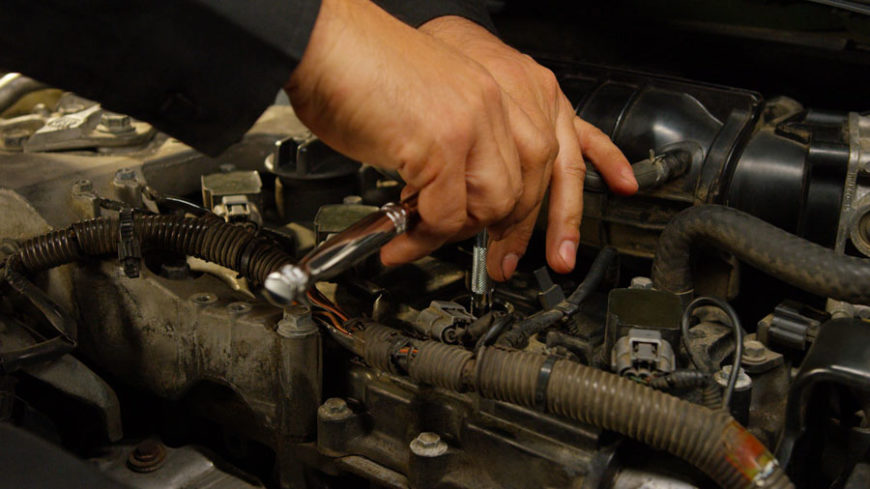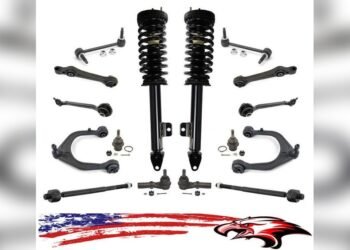Replacing spark plugs is essential for your car’s performance. They ignite the fuel, making your engine run.
Over time, spark plugs wear out and need replacing. Old spark plugs can cause starting issues, poor acceleration, and reduced fuel efficiency. Knowing when and how to replace spark plugs can save you from costly repairs. This blog post will guide you through the process.
We will explain why it’s important and how to do it yourself. Get ready to keep your engine in top shape. Let’s dive in!

Credit: www.autolite.com
Introduction To Spark Plugs
Spark plugs are small but vital components of your vehicle’s engine. They play a crucial role in igniting the air-fuel mixture. This ignition is essential for the engine’s performance and efficiency.
Role In Engine Performance
Spark plugs create the spark needed to ignite the fuel-air mixture. This ignition process powers the engine. Good spark plugs ensure smooth engine operation. They help the engine start quickly and run efficiently.
Faulty spark plugs can lead to engine misfires. They can reduce fuel efficiency and increase emissions. Regularly checking and replacing spark plugs is essential. This ensures optimal engine performance and longevity.
Signs Of Worn Spark Plugs
Worn spark plugs can show several signs. Here are some common symptoms:
- Hard Starting: The engine takes longer to start.
- Poor Fuel Economy: Increased fuel consumption.
- Engine Misfires: Jerky or rough engine operation.
- Reduced Acceleration: Sluggish engine response.
- Rough Idling: Engine shakes or vibrates at idle.
Address these signs promptly. Replacing worn spark plugs can restore engine performance. It also improves fuel efficiency and reduces emissions.

Credit: www.autozone.com
Tools And Materials Needed
Replacing spark plugs is essential to keep your engine running smoothly. To make the job easier, you need the right tools and materials. This guide will help you gather everything you need.
Essential Tools
- Spark plug socket: Ensure it fits your spark plugs.
- Ratchet wrench: Allows easy turning of the socket.
- Extension bar: Helps reach deep-set spark plugs.
- Gapping tool: Measures and adjusts the spark plug gap.
- Torque wrench: Ensures proper tightening without over-torquing.
- Swivel socket: Useful for hard-to-reach spark plugs.
Recommended Materials
- New spark plugs: Choose ones compatible with your vehicle.
- Anti-seize compound: Prevents spark plugs from sticking.
- Dielectric grease: Protects against moisture and corrosion.
- Clean rags: Keeps your hands and tools clean.
- Owner’s manual: Provides specific instructions for your car.
Preparing Your Vehicle
Change your vehicle’s spark plugs regularly for better engine performance. New spark plugs ensure smooth starts and efficient fuel use.
Before you start replacing spark plugs, prepare your vehicle properly. This step ensures a smooth and safe process. Proper preparation saves time and prevents potential issues. Here are some essential steps for getting your vehicle ready.Safety Precautions
First, ensure your car is parked on a flat surface. Engage the parking brake to prevent any movement. Turn off the engine and let it cool down completely. Hot engine parts can cause burns. Wear safety gloves and goggles to protect your hands and eyes. Disconnect the battery to avoid electrical shocks. Keep a fire extinguisher nearby for added safety.Locating Spark Plugs
Next, locate the spark plugs in your engine. Refer to your vehicle’s manual for exact details. Typically, spark plugs are found on top of the engine block. Look for a row of wires leading to the plugs. Remove any covers or components that obstruct access. Identify the number of spark plugs your engine has. Most cars have four, six, or eight spark plugs. By following these steps, you ensure a safe and efficient spark plug replacement. “`Removing Old Spark Plugs
Removing old spark plugs is a key step in maintaining your vehicle. This task ensures your engine runs smoothly. It can seem daunting, but with the right guide, it’s quite simple. Here’s a detailed look at how to remove old spark plugs.
Step-by-step Guide
- Gather Your Tools: You will need a spark plug socket, a ratchet, and an extension.
- Locate the Spark Plugs: Open the hood and locate the spark plugs. They are usually on top of the engine.
- Remove the Ignition Coil: Carefully remove the ignition coil or wire boot. This exposes the spark plug.
- Use the Spark Plug Socket: Attach the socket to the ratchet. Place it over the spark plug.
- Loosen the Spark Plug: Turn the ratchet counterclockwise. The spark plug should loosen.
- Remove the Spark Plug: Once loose, carefully lift out the spark plug.
Common Issues And Solutions
| Issue | Solution |
|---|---|
| Spark Plug is Stuck | Use a penetrating oil. Let it sit for a few minutes. Try again. |
| Socket Does Not Fit | Make sure you have the correct size socket. Common sizes are 5/8” and 13/16”. |
| Breaking the Spark Plug | Apply steady, even pressure. Avoid sudden movements. |
Removing old spark plugs is a straightforward task. Just follow the steps and address common issues if they arise. This will ensure your engine runs efficiently.
Installing New Spark Plugs
Installing new spark plugs is a crucial step in maintaining your vehicle’s performance. Old spark plugs can affect engine efficiency, causing poor fuel economy and misfires. Installing new ones can restore engine power and fuel efficiency.
Correct Installation Techniques
Proper installation of spark plugs is vital for engine health. Start by ensuring the engine is cool. This prevents burns and over-tightening.
First, remove the old spark plug using a ratchet wrench with a spark plug socket. Turn the wrench counter-clockwise. Once removed, check the spark plug gap of the new plug. Use a gap gauge to ensure it matches the manufacturer’s specifications.
Apply a small amount of anti-seize compound to the threads of the new spark plug. This prevents the plug from sticking and makes future removal easier. Screw the new spark plug into the engine by hand. This avoids cross-threading. Once hand-tight, use the ratchet wrench to tighten the plug. Turn it about 1/4 to 1/2 turn more. Do not over-tighten as this can damage the spark plug or cylinder head.
Ensuring Proper Fit
Ensuring the proper fit of spark plugs is essential for optimal engine performance. Check that the spark plug matches the vehicle’s specifications. This includes the thread size, reach, and heat range. Using the wrong type can cause engine damage and poor performance.
After installation, start the engine to check for smooth operation. Listen for any unusual sounds or misfires. If everything sounds normal, you’ve installed the spark plugs correctly.
For a quick reference, here is a table summarizing the steps:
| Step | Description |
|---|---|
| 1 | Ensure the engine is cool |
| 2 | Remove old spark plug with a ratchet wrench |
| 3 | Check the gap of the new spark plug |
| 4 | Apply anti-seize to the threads |
| 5 | Screw in the new spark plug by hand |
| 6 | Tighten with a wrench (1/4 to 1/2 turn) |
| 7 | Check for smooth engine operation |
Following these steps ensures your engine runs smoothly and efficiently. Proper maintenance can extend the life of your vehicle and improve overall performance.

Credit: www.reddit.com
Post-installation Checks
After replacing spark plugs, conducting post-installation checks is crucial. These checks ensure everything works smoothly. They help confirm that the new spark plugs are installed correctly.
Checking Connections
First, ensure all connections are secure. Check each spark plug wire for a snug fit. Loose connections can cause engine misfires. Inspect the wiring harness for any signs of damage. Damaged wires can lead to performance issues.
Testing Engine Performance
Next, start the engine and listen for unusual sounds. A smooth start indicates proper installation. Pay attention to the engine’s idle. It should be steady and consistent. Any rough idling suggests issues with the spark plugs.
Take the vehicle for a short drive. Observe the engine’s performance during acceleration. The engine should respond promptly without hesitation. Note any unusual vibrations or lack of power. These signs may indicate the need for further inspection.
Maintaining Spark Plugs
Maintaining your spark plugs is crucial for a smooth-running engine. Regular attention ensures better performance and longevity. Let’s dive into some essential maintenance tips and know when it’s time to replace them again.
Routine Maintenance Tips
Routine checks can prevent major issues. Here are some simple tips:
- Check regularly: Inspect your spark plugs every 10,000 miles.
- Clean deposits: Remove any carbon or oil deposits with a wire brush.
- Check gap: Use a spark plug gap tool to maintain the correct gap.
- Torque correctly: Over-tightening can damage the threads, so follow manufacturer specifications.
- Use dielectric grease: Apply on the plug boot to prevent moisture.
A small effort in routine maintenance can save a lot of time and money. It also keeps your vehicle running efficiently.
When To Replace Again
Knowing when to replace spark plugs is key. Here are some signs to watch for:
- Engine misfires: Frequent misfires indicate worn-out spark plugs.
- Starting trouble: Difficulty in starting may point to spark plug issues.
- Poor fuel economy: Drop in fuel efficiency is a red flag.
- Rough idling: If your engine idles roughly, it’s time to check the plugs.
- Check engine light: This may light up due to failing spark plugs.
Replace your spark plugs every 30,000 miles, or as recommended by the manufacturer. This ensures your engine runs smoothly and efficiently.
Benefits Of Replacing Spark Plugs
Replacing spark plugs is essential for maintaining your vehicle’s performance. Old or worn-out spark plugs can cause various issues. These issues can affect your car’s efficiency and lifespan. Let’s explore the benefits of replacing spark plugs.
Improved Fuel Efficiency
New spark plugs ensure the engine runs smoothly. This smooth operation results in better fuel combustion. Efficient fuel combustion means the engine uses less fuel. You will notice fewer trips to the gas station. Over time, you save money on fuel costs.
Enhanced Engine Lifespan
Old spark plugs can cause engine misfires. Misfires can damage engine components. Replacing spark plugs prevents these misfires. A well-maintained engine lasts longer. Regular maintenance reduces the risk of costly repairs.
Frequently Asked Questions
How Often Should Spark Plugs Be Replaced?
Spark plugs should be replaced every 20,000 to 40,000 miles. Check your car’s manual for specifics.
What Are The Signs Of Bad Spark Plugs?
Signs include engine misfires, poor fuel economy, and difficulty starting. Also, rough idling and sluggish acceleration.
Can I Replace Spark Plugs Myself?
Yes, you can. It’s a simple task with basic tools. Follow your car’s manual for guidance.
What Tools Are Needed To Replace Spark Plugs?
You’ll need a spark plug socket, ratchet, and extension. Also, a torque wrench for proper tightening.
Do Spark Plugs Affect Gas Mileage?
Yes, bad spark plugs can decrease fuel efficiency. Replacing them can improve gas mileage and engine performance.
Conclusion
Replacing spark plugs is a simple yet essential task. It boosts engine performance. Regular maintenance saves money and extends your vehicle’s life. Follow the steps carefully for best results. Always use the correct spark plug type for your car. Consult your manual for specific guidance.
Don’t ignore signs of worn spark plugs. Your car will thank you with smoother rides and better fuel efficiency. Happy driving and safe travels!

















